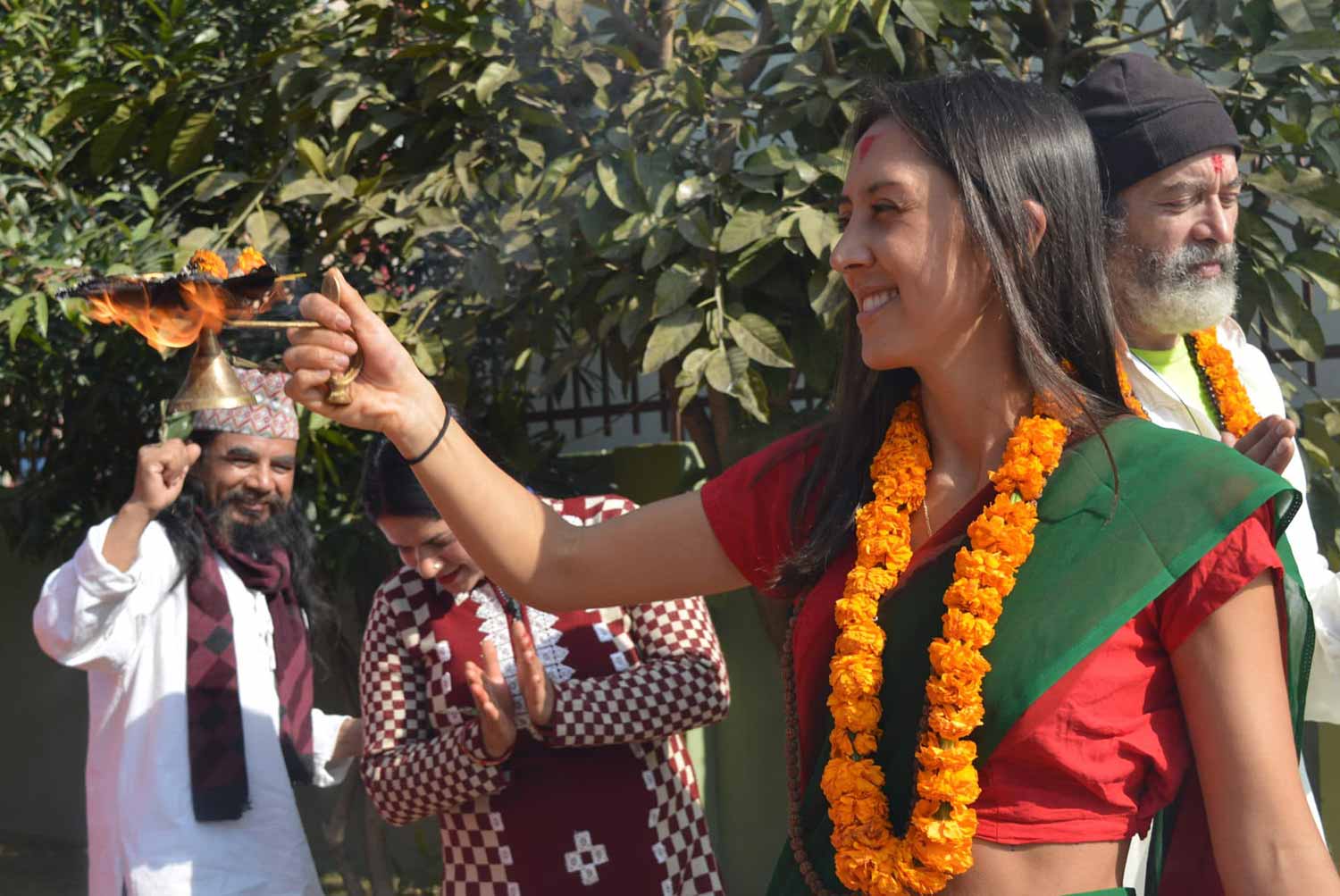
14 Apr 2021 HYN Himalayan Yoga Academy
Himalayan Yoga Academy presents an article on FUNDAMENTAL CONTENTS OF YOGA (योगको आधारभूत तत्त्वहरू ) for a better understanding. It is briefly discussed below.
Understanding of Yoga
Omkar introduction –
A-U-M Om : (Divine Power)
A – Creation / Birth; U – operation / existence / life; M – Holocaust / Resurrection/ Death
PRAYER – प्राथना
AUM /OM:
A: U: M = A……………………………………………………………….………….U…………………….………..…………M..…….
A: U: M = A…………………..……U…………………………….…………………………………………..……….M……………..….
A: U: M = A…………………U……………………..M……………….………………….………………………………….……..……..
YOGA Bandana,- GURU MANTRA:
OM Namo Guru Dev Namo! “ॐ नमो गुरु देव् नमो”-
Meaning: I bow, or salutations to the divine Master.
Meaning of Yoga as Different Texts
According to Panini Sanskrit grammar, yoga is made up of the “yuj” dhatu/root but the meaning is different for each.
I) Divadiganiya ( दिवादिगणीय), ‘Uj – Samadhau’ ‘युज – समाधौ’ from Dhaatu – Samadhi.
II) Rudhadiganiya (रुधादिगणीय), ‘Ujira Yoge dhaatu’ युजिर योगे धातु’ Samyog (Coincidence) or Mel (Union)
III) Churadiganeeya (चुरादिगणीय) -Yuj-samyamane – “युज- संयमने, restraint or regulation from root
Definition of Yoga –
I. Yoga commentator Maharshi Vyas wrote “Yoga: Samadhi“,“योग: समाधि”-Yoga is Samadhi.
II. “Yogashchittavrittinirodhah”: Pa. Su.1; 2 योगश्चित्तवृत्तिनिरोध: पा. यो. सू..१; २; Yoga + sh + Chitta (mind, ego, intellect, Consciousness) + vritti (Thoughts) 24-40 /sec. + Nirodhah – Patanjali Yoga Sutra—–Meaning: the cessation of modifications of thoughts in chitta (more about of Mind+) is yoga.
III. “Sthitametata Sven Rupena” – “स्थितमेतत स्वेन रुपेण”(Chhandogya 8.3.4) – Yoga – The soul is situated in the self-form in the state of form by samadhi.
The personality and development of a yogi – acknowledgement of Yogi’s personalites, and also developing process via yogic means.
The field and usefulness of yoga = study of different yogic feilds and need of Yoga in human life.
Identity related to yoga literatures – study fo different literatures for expanding our areas of knowledge.
The emergence of yoga and history of Yoga
Context of origin, Discussion of the interrelationship between Shiva civilization and Yoga
- Om Shiva’s Yoga Chaturtha: Hatha, Mantra, Laya and Raj Yoga – Advaita. The first disciple was Parvati and the second groups of disciples were the seven sages (Sapta Rishis).
- Description of Kailash and Himavat region and emergence of Himalayan civilization.
- Shiva na yoga inquirer, seeker, adiguru. Adiyogi, Yogeshwar, Adinath.
- Pashupatinath area as the first school of Shiva.
- Tantra Yoga as a dialogue between Shiva and Parvati, as well as Kundalini Yoga.
Tradition (परम्परा): Two traditions – Vedic and Nath (Hatha)
Vedic Tradition: Om Hiranyagarbho Yogastha Vaktaa Nasyah Puratanah! हिरण्यगर्भो योगास्थ वक्ता नास्य:पुरातन:।:. -Hirandagarbha is the oldest or the original spokesperson of yoga.
Naatha Tradition: Aadinaatha Shiva
Kaal Khand – Pre-Vedic period, Vedic period, Pre-classical, philosophy / Classical and Upanishad period, post classical and modern period.
Vedic period of yoga
Yogas in the Vedas and earlier Upanishads. The Rig Veda is the first reference text of Yoga. In 108 Upanishads, many refer to direct yoga. RIG VED – 3000 to 2000 B C. Poorva Upanishads 800- 600 BC
2. The importance or necessity of yoga in modern life
Health sector; Medical field; Education sector; Family sector; Social sphere; Political sphere; Economic sector; Mental sector; psychological sphere, Intellectual realm; Spiritual realm.
3. The discipline of yoga
Praarambha ( Initiation) Deerghakaalin (Long term);
Nirantarataa (Continuity); Shraddha (reverence);
Dhridha Prayatna (Perseverance);
4. The influential elements or obstacle elements of yoga
According to Hatha Pradeepika
Obstacles to the yoga path – Talkativeness; More labor/ Exertion; Over eating; Urging adherence to rules; More contacts; Flexibility of mind
The positive elements of the yoga path – Enthusiasm; Courage; Patience; Real knowledge; Resolution; avoiding the company of common people,
5. Objectives:
Yoga education helps in self-discipline and sales control, leading to multiple levels of consciousness, concentration and higher levels of consciousness. In a nutshell, the aims and objectives of yoga education are:
- Improve a person’s integrated health
- To practice mental hygiene
- Achieve emotional stability
- To have inner peace, purity, rest and relaxation
- Integrate moral values
- To eternizing the mind and developing concentration
- To awaken kundalini, the faminine power or spiritual energy
- Get happiness, harmony, and bliss
- To achieve a higher level of consciousness
6. Yog-charyaa (Yogic Attitudes)
1. Goals of life 2. All victorious
3. Four means – Shastra, Guru, Sadhan, Paramatma 4. Preparation of sadhanaa
5. Silent practice; 6. Mantra recitations
7. Sublime thoughts, 8. Abandoning addiction
9. Abstinence from sleep, 10. Perseverance/effort
7. General Rules of Yoga Class
Introduction of Class; Environment of venue or Hall; Arrangement of Class,
Timing of class; Dress & Clothing; Diet;
Lifestyle;
8. Discussion of the types of yoga related literature, introduction, importance and features
* Karma Yoga, Gyan Yoga, Bhakti Yoga and Dhyana Yoga mentioned in the Bhagavad Gita.
* According to Shiva Samhita, Hatha Yoga, Mantra Yoga, Laya Yoga and Raj Yoga.
* Tantra Yoga, Japa Yoga, Kundalini Yoga, Swara Yoga based on Tantra Yoga
* Sanatan Yoga, Sankhya Yoga, Kriya Yoga, Akshatanga Yoga, based on Vedic Vagmaya
9. Understanding Eastern Philosophy and the Yoga References
* Yoga elements in Vedanta and Mimamsa philosophy
* Yoga theory in Samkhya philosophy and yoga philosophy
* The importance of yoga in Nyaya and Vaishesika philosophy
* Use of yoga in Buddhist and Jain philosophy
“Hari Om Tat Sat” OM Shantih! Shantih!! Shantih !!!
